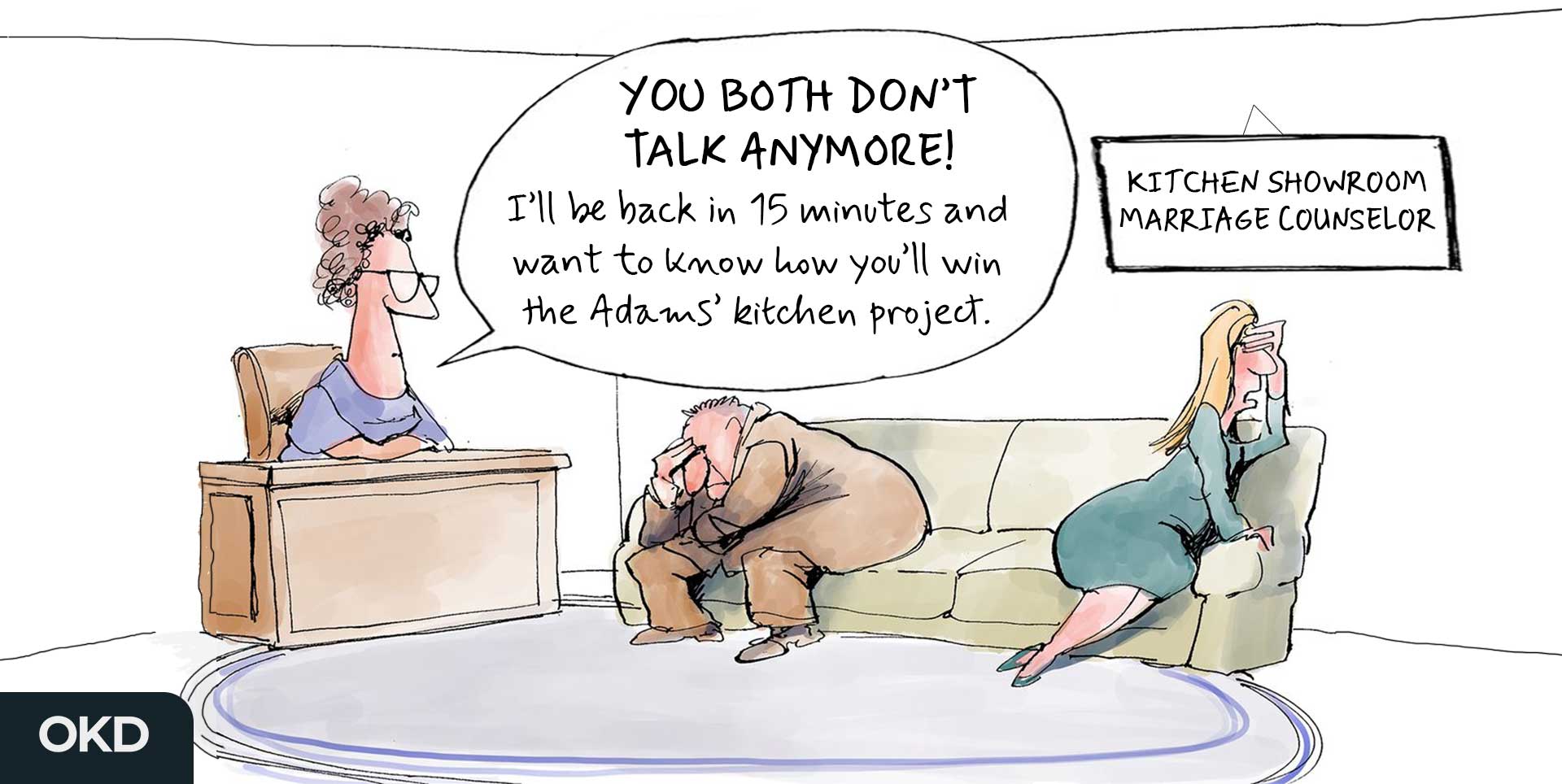One short conversation between kitchen designers and salespeople can mean the difference between winning and losing qualified sales prospects.
We call it the 15-for-90 Exchange, and it’s one of the easiest “plays” kitchen designers and salespeople can run.
It goes like this:
A salesperson dedicates 15 minutes to show a designer why and how a particular kitchen prospect will be sold.
Designers then have the necessary information to design the kitchens to capture 90% of overall sales.
Pre-design sales prospect conversations matter
I’m always surprised by how many kitchen showrooms don’t facilitate pre-sale designer/salesperson “kickoffs.”
Something as simple as a checklist of sales probability before beginning a design can help, and high-revenue showrooms usually have one. You need something to ensure the salesperson and designer are on the same page and have the same goals.
Here’s how a pre-design sales conversation can benefit the team (and your showroom)
Let’s say your salesperson has plans for a high-end, twelve-unit townhouse project.
Without the conversation, the process looks something like this:
- The salesperson leaves plans for the twelve-unit townhouse project on the designer’s desk.
- The designer does his best to design with little information and no understanding of what might assist with a positive sales outcome.
- Fingers crossed!
With the 15-for-90 Exchange, the process looks more like this:
- The salesperson must consider why the design will sell before the 15-minute designer conversation, forcing them to justify the project and consider sales probability prior to the design process. (It ensures your salesperson is in the mindset of rational sales thinking rather than wishful thinking.)
- The designer and salesperson engage in a 15-minute conversation, during which the salesperson offers insight. They discuss the design, pricing, and timeline strategies needed to sell the project.
- The designer and salesperson act as a team, with the designer having all the tools and information needed to offer genuine sales support.
If you aren’t having these conversations, you’re just guessing at your chances of making a sale.
Guessing is bad business.
Kitchen designer sales support doesn’t just happen
Team-building exercises are popular, and you may already have put effort into facilitating connections between your designers and sales team. (Boozy happy hours are a popular choice!)
Some of our partners have tried:
- Increasing designer sales commissions.
- Requiring a minimum amount of design info before designing.
- Filtering information to qualify sales prospects.
- Hiring more designers.
All with the goal of promoting the advantages of designer sales support.
But you don’t need all that.
The 15-for-90 Exchange makes sales support (and sales) happen
Making this conversation an expectation instead of an option will level the playing field and unite your designers and salespeople toward a common goal.
Kitchen designers don’t know the sales outcomes of what they’re designing, and they probably won’t go digging for additional information. The sales team is often in their own little world and think designers can read their minds.
The 15-for-90 Exchange requires the designers and sales team to communicate and work together.
How to Implement the 15-for-90 Exchange
You’re the boss! Don’t permit new designs without first requiring this essential interaction between your salesperson and designer.
Empower both teams by giving them the tools to understand—and discuss—what will sell. Then, follow this protocol:
- Create a checklist outlining timeline, competitors, and your company’s value proposition.
- Require the salesperson and designer to qualify the prospect together.
- If the design is green-lit, ensure the designer clearly understands the design requirements.
- Now, your designers will feel like a valued part of the sales process and know which designs to prioritize.
Unite your sales and design teams with a single conversation
By implementing the 15-for-90 Exchange, you’ll create a sales support team motivated to work towards a single goal: selling.
The old way is two groups with distinct motivations that cancel sales.
The new way is a united front with a single motivation and sales growth.
Congratulations! You’ve added sales support, increased sales, and instilled a team spirit, all thanks to one fifteen-minute conversation.
Interested in working with OKD? Learn more here.
We’re a team of professional kitchen designers providing fast, unlimited designs. Let’s discuss our free-trial design program.
One short conversation between kitchen designers and salespeople can mean the difference between winning and losing qualified sales prospects.
We call it the 15-for-90 Exchange, and it’s one of the easiest “plays” kitchen designers and salespeople can run.
It goes like this:
A salesperson dedicates 15 minutes to show a designer why and how a particular kitchen prospect will be sold.
Designers then have the necessary information to design the kitchens to capture 90% of overall sales.
Pre-design sales prospect conversations matter
I’m always surprised by how many kitchen showrooms don’t facilitate pre-sale designer/salesperson “kickoffs.”
Something as simple as a checklist of sales probability before beginning a design can help, and high-revenue showrooms usually have one. You need something to ensure the salesperson and designer are on the same page and have the same goals.
Here’s how a pre-design sales conversation can benefit the team (and your showroom)
Let’s say your salesperson has plans for a high-end, twelve-unit townhouse project.
Without the conversation, the process looks something like this:
- The salesperson leaves plans for the twelve-unit townhouse project on the designer’s desk.
- The designer does his best to design with little information and no understanding of what might assist with a positive sales outcome.
- Fingers crossed!
With the 15-for-90 Exchange, the process looks more like this:
- The salesperson must consider why the design will sell before the 15-minute designer conversation, forcing them to justify the project and consider sales probability prior to the design process. (It ensures your salesperson is in the mindset of rational sales thinking rather than wishful thinking.)
- The designer and salesperson engage in a 15-minute conversation, during which the salesperson offers insight. They discuss the design, pricing, and timeline strategies needed to sell the project.
- The designer and salesperson act as a team, with the designer having all the tools and information needed to offer genuine sales support.
If you aren’t having these conversations, you’re just guessing at your chances of making a sale.
Guessing is bad business.
Kitchen designer sales support doesn’t just happen
Team-building exercises are popular, and you may already have put effort into facilitating connections between your designers and sales team. (Boozy happy hours are a popular choice!)
Some of our partners have tried:
- Increasing designer sales commissions.
- Requiring a minimum amount of design info before designing.
- Filtering information to qualify sales prospects.
- Hiring more designers.
All with the goal of promoting the advantages of designer sales support.
But you don’t need all that.
The 15-for-90 Exchange makes sales support (and sales) happen
Making this conversation an expectation instead of an option will level the playing field and unite your designers and salespeople toward a common goal.
Kitchen designers don’t know the sales outcomes of what they’re designing, and they probably won’t go digging for additional information. The sales team is often in their own little world and think designers can read their minds.
The 15-for-90 Exchange requires the designers and sales team to communicate and work together.
How to Implement the 15-for-90 Exchange
You’re the boss! Don’t permit new designs without first requiring this essential interaction between your salesperson and designer.
Empower both teams by giving them the tools to understand—and discuss—what will sell. Then, follow this protocol:
- Create a checklist outlining timeline, competitors, and your company’s value proposition.
- Require the salesperson and designer to qualify the prospect together.
- If the design is green-lit, ensure the designer clearly understands the design requirements.
- Now, your designers will feel like a valued part of the sales process and know which designs to prioritize.
Unite your sales and design teams with a single conversation
By implementing the 15-for-90 Exchange, you’ll create a sales support team motivated to work towards a single goal: selling.
The old way is two groups with distinct motivations that cancel sales.
The new way is a united front with a single motivation and sales growth.
Congratulations! You’ve added sales support, increased sales, and instilled a team spirit, all thanks to one fifteen-minute conversation.
Interested in working with OKD? Learn more here.
We’re a team of professional kitchen designers providing fast, unlimited designs. Let’s discuss our free-trial design program.
We’re a team of professional
kitchen designers providing fast,
unlimited designs. Let’s discuss
our free-trial design program.


